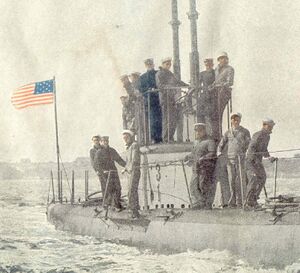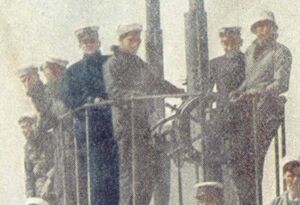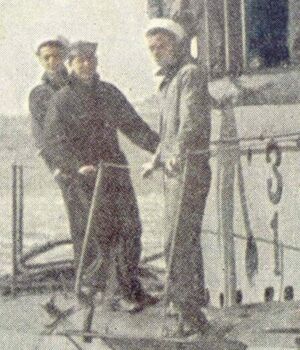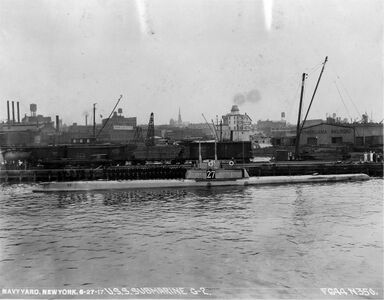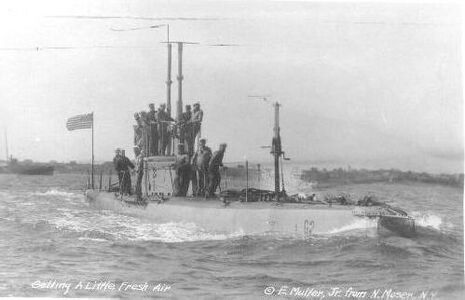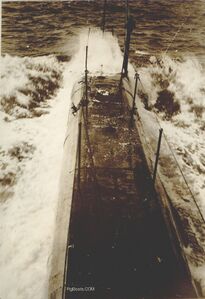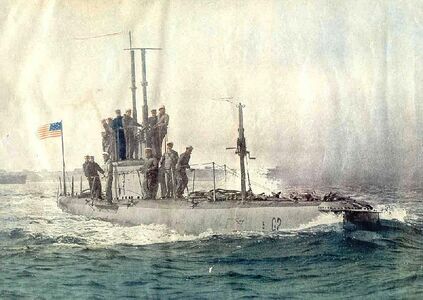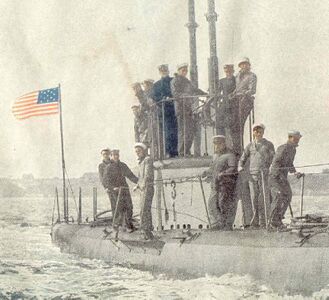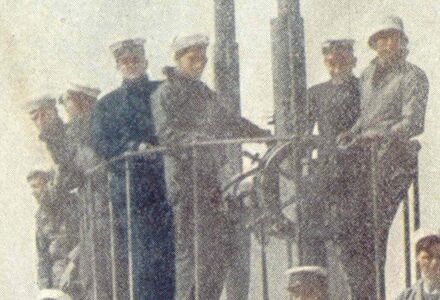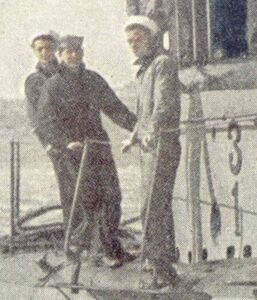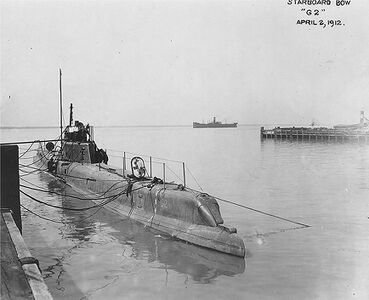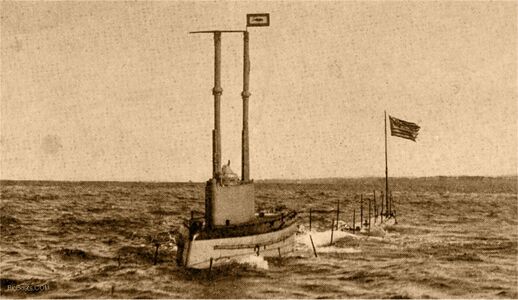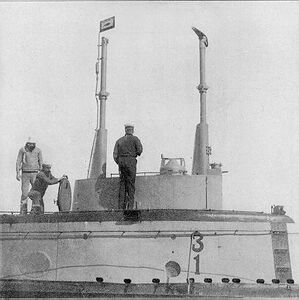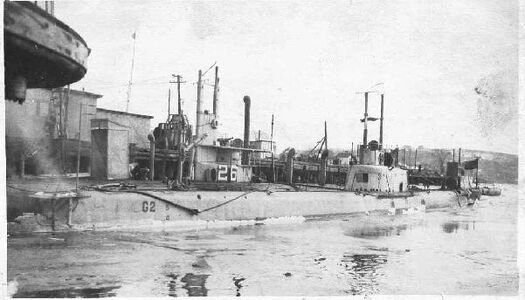G-2

The USS G-2 during her fitting out phase of construction. She is probably pretty close to being completed by the time this photo was taken. The small deck over the torpedo tube outer door has not been installed at this time. There is a man working over the side on the starboard side. He has his feet on a scaffolding board slung over the side and is crouched down. There is another workman going over the port side of the hull and a man standing on the top of the conning tower.
The USS G-2 diving. The location is not certain but could be a selection of places where she conducted practice cruises that found her at Norfolk, Charleston, New York, Newport, and Provincetown. The shoreline looks to be too high for Provincetown but may be the Newport area.
Note that the flag staff and flag have not been removed so this may have been a dive made for publicity purposes, down and back up again. It is definitely a test dive as the "fish flag" is being flown from the number two periscope.
This photo was originally identified as the G-4 but the error was caught by Dave Johnston and brought to our attention.
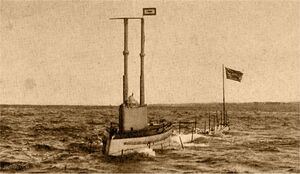
Paul Frederick Foster was born on March 25, 1889 in Wichita, Kansas. He received a senatorial appointment from the State of Idaho to the U.S. Naval Academy. Following graduation in 1911, he served in the armored cruiser Washington and the battleship Utah as a midshipman and, in March 1912, was commissioned as an Ensign. On 21-22 April 1914, Foster participated at the intervention at Vera Cruz, Mexico, leading his landing company with skill and courage. For his "distinguished conduct in battle", he was awarded the Medal of Honor.
Vivamus vestibulum ex a dui congue feugiat. Aliquam dictum nunc vitae erat malesuada, eget pretium enim dictum. Fusce eu viverra arcu, vulputate finibus nunc. Maecenas elit ante, cursus a scelerisque ut, consequat vel nisl. Nam a ultrices urna. Fusce felis ipsum, vulputate sit amet auctor nec, lacinia vitae quam.
Aliquam ut lacus non urna ornare semper. Praesent pellentesque pulvinar felis, quis dignissim metus laoreet sed. Proin eleifend ligula at porttitor porta.
This is a hand tinted picture of the G-2.
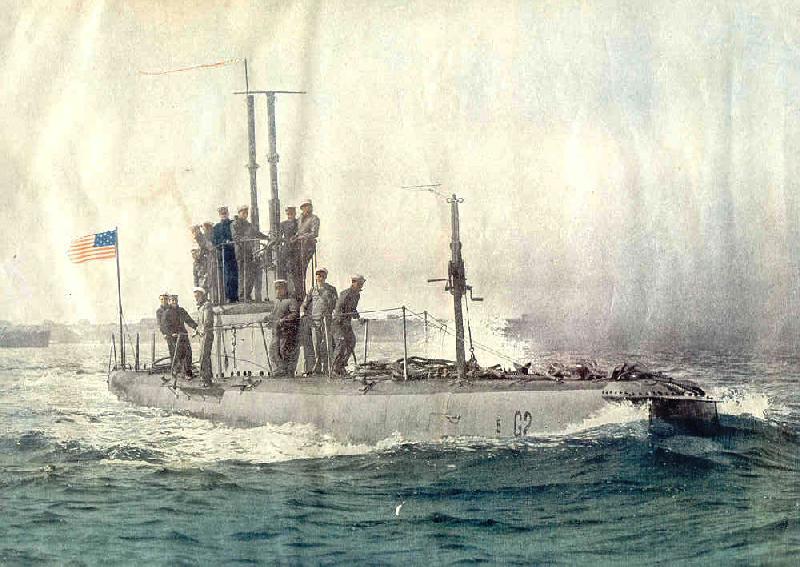
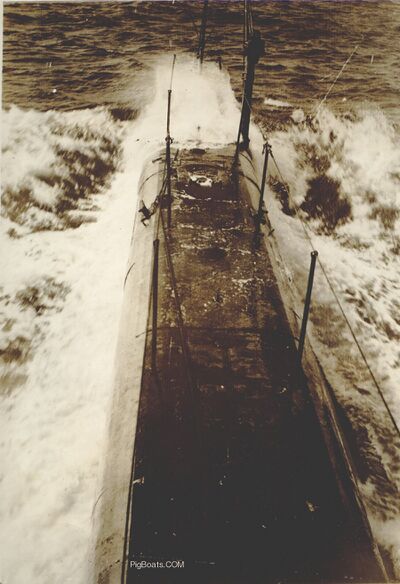
When the US entered the war in 1917 our allies had been in the fight for nearly three years. They had for those three years been climbing the learning curve of submarine and anti submarine warfare. We were watching, learning some and not much else. For these three years, our submarine design had gone from the E and F Class which had been started in 1909 and were only now one to two years old through the O and R classes which were authorized and being laid on the ways.
This great advance in submarine technology would not be able to be translated into operational first line submarines able to go to war for the US until late 1918 at the soonest and most likely it would be into the 1920/21 time frame. Thus, the US would have to go to war with what was available. That consisted of the A and B classes now at Manila Bay, the three D-Class which were not ocean going boats, the F-Class and the E-Class which were small but capable of making the crossing (the F-4, of course was not available, having been lost in 1915 off Honolulu), three H-Class were operating off the west coast with the F boats, the K-class whose 8 boats were split between east and west coasts, the L-Class which were just now coming on line and the N-class which were also just being commissioned. The boats in which there were the most experienced crews were the K boats followed by the E and F boats on the west coast so this set was chosen to get up to speed and transit to the advanced base at Punta Delgada, Azores and Queenstown, Ireland to take their place alongside the British boats.
The summer of 1917 was spent in fixing the boats and in training for what we could foresee would be an antisubmarine war. By November we had a flotilla ready to go to the Azores to protect shipping around the islands from the actions of German raiders and submarines. The K-1, 2, 5, 6, and E-1, constituting SubDiv Four assembled at Newport, Rhode Island for the haul across the Atlantic. All except the E-1 were to make the trip, with that boat following the next month. The four K boats, plus the tender Bushnell sailed from Newport to Provencetown then to Halifax. After fueling and replenishing supplies they set off for Punta Delgada. The crossing was horrible. The storm they hit the second day out scattered the group and it was not until after the 27th that they all assembled again in the Azores.
The Fifth Division after spending a few days in the Azores got underway for Queenstown. As in their transit across the Atlantic, the division slammed head on into a storm. It took eight days to cover the transit through the storm. The L-10 was separated from the remainder of the division and held forth against the storm finally making Queenstown. It was on this transit that L-10 lost a man overboard. GM1 R.A. Leese became the first US submarine causality in a war zone. Lieutenant E. W. F. Childs of the L-2 became the second when he went down with the HMS H-5 also operating out of Bantry Bay.
-
orem ipsum dolor sit amet, consectetur adipiscing elit.
-
Morbi ac nunc quis lacus sagittis dignissim.
-
Fusce auctor purus id erat bibendum efficitur.
-
In et dolor eu mi vestibulum lacinia nec non diam. Lorem ipsum dolor sit amet, consectetur adipiscing elit.
-
Donec condimentum erat quis pharetra venenatis.
-
Nunc aliquam, non ornare eros erat a diam.
-
Nunc aliquam, purus libero egestas massa, non ornare eros erat a diam.
-
purus libero egestas massa, non ornare eros erat a diam.
-
Nunc aliquam, dolor non pellentesque gravida, purus libero
-
Nunc aliquam, dolor non pellentesque gravida.
-
Pulvinar rutrum ante. Donec eget ultricies dolor, et feugiat tortor.
-
Nulla nec ultricies nisl. Cras purus ligula fermentum non dolor sed.
-
Nulla nec ultricies nisl.
